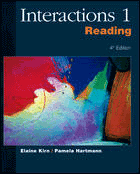 |  Interactions 1 Reading, 4e Elaine Kirn,
West Los Angeles College
Pamela Hartmann,
Los Angeles Unified School District
ReadingA. Using Strategies for Reading a Passage
Get students into the habit of reading a passage at least twice. Both times they should read with pencil in hand. The first time, they should read fairly quickly for the main ideas and to underline or circle problem areas. The next time, they should read more closely and carefully, picking up on the details and trying to figure out some ideas that they missed in the first reading. It will usually be useful for them to read a third time in order to mark important sections (See Marking Up a Text below).
Each student should read the passage silently the first time. If some students move their lips as they read, point out that this will slow them down. Do not let them use a dictionary the first time through. Tell them to underline words or sections that they do not understand. Emphasize the importance of simply getting the main idea. Do not have students read aloud. Reading aloud reinforces neither speed nor comprehension.
- Encourage students to read faster by telling them to read a section as quickly as possible and then look up unknown words when they are finished. When most students have finished, ask one or two very general comprehension questions. (Reading fast is useless if you don't understand what you've read.) If many students cannot answer, have them go back and reread. Then give them another section to read, but tell them to read a bit more slowly.
- Reading and listening is an activity that will help students recognize the pronunciation of English. However, it should not generally be used as a listening comprehension activity. It should be done after students have a basic understanding of the reading.
Reading is often best done as a homework activity, especially in higher levels, where the passages can be quite long. However, the prereading should be done in class beforehand.
B. Dealing with Unknown Words
Students are often frustrated when they encounter a number of unknown words in a reading. It is important that they learn to tolerate ambiguity. They need to learn to simply note the word and keep reading. They should not stop reading unless they are unable to extract any information from the passage. Then they should reread, consciously trying to guess the meanings of the words in context. Teach students the following strategies for guessing the meaning of a word in context:
- Use suffixes, prefixes, and roots. (For example, beautification probably relates to beauty, and -ation indicates that it is a noun.)
- Use definitions or restatements often found in the same sentence in parentheses or after dashes or commas.
- Use the pictures, photographs, maps, graphs, or charts that accompany the reading.
- Use grammatical clues, such as but and and.
Sometimes it is not possible to guess the exact meaning of a word. For example, students might only be able to figure out that the word is a noun that refers to some kind of tool or that the word is an adjective that is probably a negative attribute. In many cases, this is enough information to allow them to continue reading.
Although dictionaries are useful, students must learn when to use them. Students should follow the following steps before they look in a dictionary.
1. At first, continue reading.
2. Decide that the word is important.
3. Try to guess the meaning in context.
4. If unsuccessful, look in a dictionary.
C. Marking Up a Text
Another important skill that students should acquire is marking texts in some way. This is particularly important for academic reading. Even advanced students may need guidance in this skill. Demonstrate different ways of noting important passages in a text—highlighting, bracketing, underlining, making marginal notes, and so on. Point out that notes often omit pronouns, auxiliary verbs, articles, and connectors. Encourage students to use symbols and abbreviations when appropriate. Give students a chance to practice marking up texts and to compare their work with other students.
Some students like to write translations in the margins of reading passages. This habit should not be reinforced. While it does no harm to note the occasional word, extensive translation does not help students to improve their English reading skills.
|
|



 2002 McGraw-Hill Higher Education
2002 McGraw-Hill Higher Education

 2002 McGraw-Hill Higher Education
2002 McGraw-Hill Higher Education